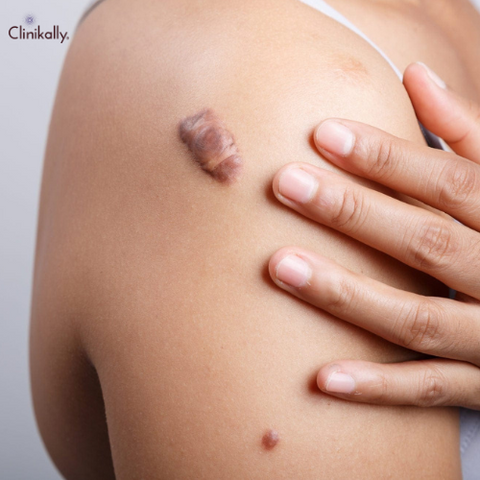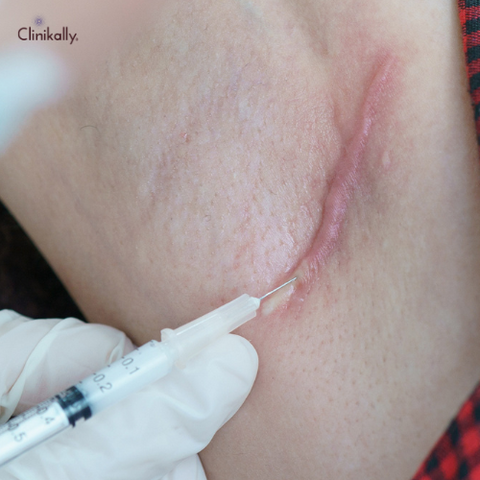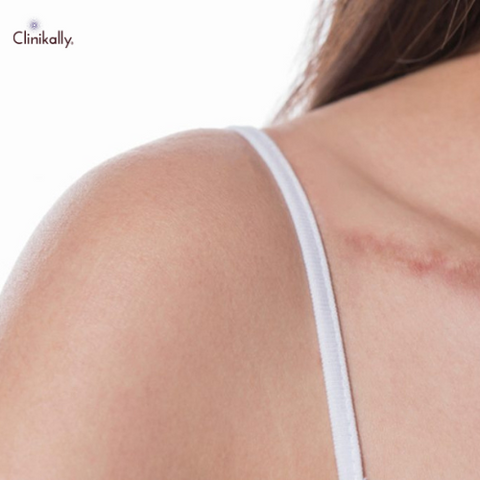Keloids are raised, thick, and frequently unsightly scars that develop following an injury or surgery. Scars can be itchy and uncomfortable, causing self-consciousness and embarrassment. While keloids are not harmful to your health, they can be difficult to treat and may necessitate multiple treatments to completely remove them. It should be noted that keloids can be difficult to treat, and multiple treatments may be required to achieve the desired results. Furthermore, keloids may reappear even after successful treatment. It's also critical to avoid any activities that could aggravate the keloid, such as piercings or tattoos. If you are concerned about a keloid scar, it's best to speak with a dermatologist who can recommend the most appropriate treatment for your individual case.
Introduction

When the skin is injured, a fibrous tissue known as scar tissue forms over the wound to repair and protect it. In some cases, extra scar tissue forms, resulting in smooth, hard growths known as keloids. Keloids can grow to be significantly larger than the original wound. They can be found on the chest, shoulders, earlobes, and cheeks. Keloids, on the other hand, can affect any part of the body.
What are Keloids?
To protect burned or acne-scarred skin, keloid scars form. They may flatten over time, but some people prefer to have them surgically removed. They happen when the body makes too much collagen while healing, leading to tissue overgrowth that grows past the initial wound. Keloids can be either firm, rubbery, and smooth, or rough, ridged, and bumpy. They can become larger than the original wound and can be pink or dark brown in color. Keloids are often itchy and uncomfortable, and they can make people feel self-conscious and embarrassed, especially if they are noticeable. Keloids can form anywhere on the body, but the chest, shoulders, back, and earlobes are the most common. While keloids are not harmful to your health, they can be difficult to treat and may require multiple treatments to get rid of them completely.
The Causes and Symptoms of Keloids
Keloids have no known cause, but they frequently appear after an injury or surgery. Minor skin injuries, such as acne, burns, piercings, or insect bites, can also cause them to form. Keloids are more common in people with darker skin tones and may be inherited. Keloids are characterized by raised, thick, and firm scars; smooth or rough skin texture; discoloration ranging from pink to dark brown; itching or tenderness in the scar area; scar growth beyond the original wound, and a proclivity to recur after treatment.
Keloids can form anywhere on the body, but the most common locations are the chest, shoulders, back, and earlobes. Keloids can be painful, particularly if they are in an area where clothing or jewellery rubs against them. They can also cause embarrassment and self-consciousness, especially if they are visible.
How are Keloids Different from Other Scars?
Keloids, unlike other scars, grow beyond the original wound and do not fade over time. Keloids are raised, thick, and firm to the touch, whereas other types of scars may be flat or sunken. Keloids can range in color from pink to dark brown and have a smooth or rough texture. Keloids are frequently itchy and tender to the touch, which is not a characteristic of other types of scars. Keloids are more common in people with darker skin tones and can develop as a result of minor skin injuries such as acne, piercings, or insect bites. Other scars, on the other hand, are usually the result of a significant injury or surgery. Keloids, unlike other scars, are more likely to recur after treatment.
Treating Keloids with Medical Procedures
Keloids can be treated with a variety of medical procedures. The size, location, and severity of the keloid, along with the patient's medical history and skin type, all play a role in determining the treatment strategy. The following are some of the most commonly used medical treatments for keloids:
-
Corticosteroid injections: Corticosteroid injections, like those of triamcinolone acetonide, can help shrink keloids and lessen tenderness and itching.
-
Cryotherapy: Liquid nitrogen freezing of the keloid can help to flatten its appearance and reduce its size.
-
Laser therapy: By concentrating on the blood vessels and collagen in the scar tissue, laser therapy can help reduce the redness and thickness of keloids.
-
Surgery: Surgery can be used to remove keloids, but there is a significant chance of recurrence and it also has the potential to make the keloid worse.
-
Radiation therapy: Pregnant women and young children should not receive low-dose radiation therapy as it may contribute to the recurrence of keloids after surgery.
-
Silicone gel or sheets: Applying silicone gel or sheets to the keloid over time can help it become less pronounced and shrink in size.
-
Pressure therapy: Using bandages or pressure garments can help reduce the size and thickness of keloids.
Surgery for Keloid Removal
Surgery, especially for larger or more complex scars, can be an effective way to remove keloids. However, there are risks to keloid removal surgery, including the possibility of the keloid growing back even larger than before. Before undergoing keloid removal surgery, a dermatologist or plastic surgeon will assess the keloid's size, location, and severity and create a personalized treatment plan. Before using sutures or staples to close the wound, the surgeon will typically remove the keloid and any surrounding scar tissue. Patients may experience some pain, swelling, and redness following surgery, which can be managed with over-the-counter pain medication and cold compresses. Patients must also keep the wound clean and dry, and they may need to wear a pressure garment or bandage to prevent the keloid from returning.
Cryotherapy for Keloid Treatment
Liquid nitrogen is used in cryotherapy, a keloid treatment, to freeze the affected area and obliterate the extra scar tissue. The procedure is also referred to as cryosurgery or cryoablation. During the procedure, the dermatologist or physician uses a spray or a cotton swab to apply the liquid nitrogen to the keloid. This causes the keloid tissue to freeze, resulting in its destruction. Cryotherapy is a quick and painless procedure that can be performed in a clinic or doctor's office. It is frequently used for smaller keloids that have not spread beyond the site of the initial injury. Cryotherapy can also be combined with other keloid treatments, such as corticosteroid injections, to improve outcomes. A local anaesthetic or topical numbing cream can be used to manage any minor discomfort or pain that may be experienced during the procedure, which typically lasts 5 to 10 minutes. After the procedure, patients might experience swelling, redness, and blistering, but these side effects typically go away within a few weeks.
Laser Therapy for Keloids
Laser therapy is a non-invasive keloid treatment that uses laser beams to break down scar tissue. The procedure can help reduce the size and appearance of keloids, as well as relieve symptoms like itching and pain. Laser therapy, such as pulsed-dye laser, carbon dioxide (CO2) laser, and fractional laser, can be used to treat keloid lesions. Each type of laser works slightly differently, but they are all designed to selectively target excess scar tissue while leaving healthy skin alone.
Depending on the size and severity of the keloid, the procedure usually takes between 15 and 30 minutes. During the procedure, patients may experience some discomfort or pain, which can be managed with a local anesthetic or topical numbing cream. In general, laser therapy is safe and effective, with few side effects. However, there is a small risk of complications such as scarring, skin discoloration, and infection, as with any medical procedure. It is crucial to go over the advantages and disadvantages of laser therapy with a licensed healthcare professional before starting.
Alternative Treatments for Keloids

There are a number of complementary therapies besides medical procedures that can be used to treat keloids. These consist of:
-
Silicone gels or sheets: By hydrating the skin and lowering collagen production, silicone can aid in the flattening and reduction of keloids in size. The affected area is typically covered with silicone sheets or gels for several hours each day.
-
Pressure therapy: Using bandages or compression clothing to apply pressure to the keloid may help to reduce the thickness and size of the scar.
-
Onion extract: According to some studies, putting onion extract on keloids can help to soften and shrink the scar. This medication might be offered as a cream or gel.
-
Vitamin E: Applying vitamin E oil or cream to a keloid scar may help to reduce its visibility and soften the scar. The effectiveness of this treatment is however only partially supported by scientific research.
-
Essential oils: Some essential oils, including lavender and tea tree oil, may have anti-inflammatory and antimicrobial properties that can help to lessen the size and appearance of keloids. However, these oils need to be diluted properly before use and used with caution.
Steroid Injections for Keloids
Keloids are commonly treated with steroid injections. To reduce inflammation and shrink the scar tissue, corticosteroids are injected directly into the keloid. This treatment can help to flatten and soften the keloid, reducing its visibility. To achieve the desired results, steroid injections may need to be repeated several times over the course of several weeks or months. The number of injections required will vary according to the size and severity of the keloid. While steroid injections can be effective in treating keloids, there are some risks to be aware of. Skin thinning, discoloration, and the formation of small blood vessels in the treated area are all possible side effects.
Silicone Sheets for Keloid Treatment
Another option for treating keloids is to use silicone sheets. These are flat, adhesive silicone sheets that can be applied to the keloid to help flatten and reduce its size. The silicone hydrates the skin and inhibits collagen production, which can soften and flatten the keloid over time. For several months, silicone sheets should be applied to the keloid for several hours each day. The duration of treatment will depend on the size and severity of the keloid. The use of silicone sheets has the advantage of being non-invasive and generally well-tolerated. They do not cause pain or discomfort, and they usually have no negative side effects.
Home Remedies for Keloid Prevention
While there are no guaranteed home remedies for preventing keloids, there are some steps you can take to reduce your risk of developing these scars:
-
Keep the area clean and well-moisturized: This can help to promote healing and reduce the risk of scarring. Using harsh soaps or cleansers that can dry out the skin should be avoided.
-
Apply sunscreen: Shielding your skin from the sun's rays can aid in preventing the formation of scars. Every time you are in the sun, wear broad-spectrum sunscreen with an SPF of at least 30.
-
Avoid getting tattoos or piercings in areas prone to keloids: If you've had keloids in the past, you should stay away from getting tattoos or piercings in places like the earlobes, chest, or shoulders.
-
Immediately treat skin conditions like acne: Keloid formation is more likely to occur following skin damage or inflammation. Scarring can be reduced by treating skin conditions like acne or eczema as soon as they appear.
-
Massage the area: A light massage can aid in removing scar tissue and accelerating recovery. This is particularly potent when combined with other therapies like silicone sheets or steroid injections.
Post-Treatment Care for Keloids

After keloids treatment, it's essential to take action to promote healing and prevent scars from resurfacing. Here are some pointers for aftercare:
-
The best ways to take care of the treated area will be explained to you by your doctor. To ensure the best possible healing, be sure to carefully adhere to these directions.
-
Proper healing depends on keeping the treated area clean and infected-free. Your doctor might advise using a particular brand of soap or cleanser.
-
Scars may darken and stand out more as a result of exposure to the sun. Use clothing to shade the treated area from the sun, or apply a broad-spectrum sunscreen with an SPF of at least 30.
-
Keloid scars can be flattened and made to appear less noticeable with the aid of silicone sheets or gel. Following treatment, your doctor might advise using these products for a few weeks or months.
-
Scar tissue can be broken up and healing accelerated with gentle massage. Your doctor might advise daily, lengthy massages of the treated area.
-
The skin can stay hydrated and heal faster if you drink plenty of water.
-
It may take several months to notice a noticeable improvement in keloid scar healing. For best results, be patient and adhere to your doctor's recommendations.
Wound Care and Scar Management
A vital component of maintaining healthy skin and regaining function after injury or surgery is the management of wounds and scars. Infection can be avoided and healing can be accelerated with proper wound care, and scar management can help improve skin function and lessen the visibility of scars. The following tips for dealing with scars and wounds include keeping the wound clean, avoiding picking at scabs or crusts, moisturizing the wound, applying sunscreen, using silicone sheets or gel, massaging the scar, and considering scar treatment options such as laser therapy, corticosteroid injections, or surgery. Remember that each wound and scar is unique, and it's critical to follow your doctor's wound care and scar management recommendations to promote optimal healing and improve the appearance and function of your skin.
Skin Rejuvenation after Keloid Treatment
Skin rejuvenation involves returning the skin to its natural state following keloid treatment, minimizing scarring and discoloration, and encouraging healthy skin regrowth. Keloid treatment can cause skin damage, so it's critical to give your skin the time and attention it needs to heal properly. Keeping the area clean and moisturized is an important part of skin rejuvenation after keloid treatment. Your doctor might suggest using a particular cream or ointment on the affected area to keep it moisturized and encourage healing. It is also critical to avoid exposing the treated area to direct sunlight, which can cause additional damage and discoloration. Promoting healthy skin regrowth is another important aspect of skin rejuvenation after keloid treatment. This can be accomplished by eating a nutritious diet rich in vitamins and minerals that promote skin health, such as vitamin C, vitamin E, and zinc. Regular exercise can also help to improve blood flow and promote healthy skin cell regeneration.
Preventing Future Keloid Formation
Since there is no sure-fire way to completely stop them from forming, preventing future keloid formation can be challenging. There are, however, steps you can take to reduce your risk of developing keloids or to lessen their severity if they do develop. One of the most crucial things you can do to prevent future keloid formation is to prevent skin injury. One example is avoiding unnecessary tattoos, piercings, and other cosmetic procedures that can damage the skin and result in keloid formation. If you do decide to get a piercing or tattoo, make sure you choose a reputable provider and carefully follow all aftercare instructions.
Keeping your skin healthy and moisturized is another important step in preventing future keloid formation. Use a mild, fragrance-free moisturizer every day because skin that is dry or damaged is more prone to keloids. Additionally, you should avoid using abrasive or harsh skincare products because they can damage your skin and cause the formation of keloid scars. You should take extra care to protect your skin if you have a history of keloids or are predisposed to getting them. This might entail staying away from practices like contact sports and heavy lifting that could harm the skin. You might want to think about using silicone gel sheets or other preventative measures suggested by your doctor to lessen the likelihood of keloid formation in the future.
Conclusion

Keloids can be both frustrating and emotionally draining for those who suffer from them. There are, however, a number of keloid removal treatment options available, from surgical procedures to home remedies. It is crucial to speak with a dermatologist or other licensed healthcare provider before starting any keloid treatment. In order to prevent future keloid formation, maintaining proper wound care and scar management is also essential. Individuals can improve the appearance of their keloids and boost their self-confidence with the right treatment plan and post-treatment care.
















